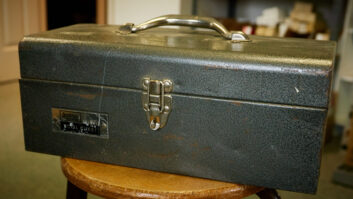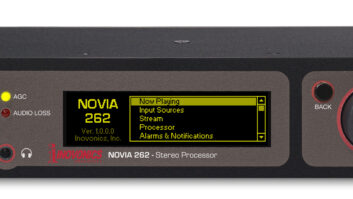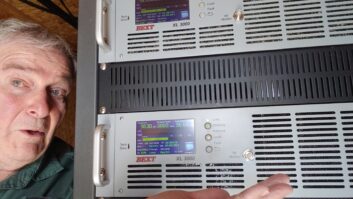In the Dec. 3 Workbench we noted, “Plug conduit openings like this one to keep out the elements — and worse.”
Marc Mann writes to suggest that before you plug any such conduit, take the extra step of ensuring it’s empty of water. Fig. 1 shows cables disappearing into a conduit. It’s what you can’t see that can cause problems.

Fig. 1: Before sealing conduits, ensure they are water-free to avoid damage to cabling. When Marc’s CATV picture degraded, the tech who was sent narrowed the problem to the coax cable between the street pedestal and the building. It was housed in an underground PVC conduit that terminated in the pedestal vertically with no seal. When the tech pulled the cable out, they found its jacket was severely degraded and soaking wet, due to the conduit being flooded.
The technician was going to just pull a new cable through when Marc suggested he blow the conduit out first and then seal it. The technician didn’t carry compressed air on his truck, but Marc offered his air compressor; they used it to remove a couple of gallons of stagnant water. After pulling the new cable, the tech sealed the ends to prevent such problems in the future.
Don’t think you have compressed air at the site? How about utilizing a spare nitrogen bottle from your RF line to blow it clear — using a regulator, of course.
Construct a suitable-grade rubber air hose (any length) with the appropriate fittings attached to the nitrogen regulator; it’s handy for blowing out dust from heat sinks, hard-to-access equipment racks and air conditioning condensing coils.
Hose, blow gun and regulator kits are available from any commercial refrigeration supply house in your area. Here’s a link, for example, to AZ Partsmaster: tinyurl.com/workbench1.
Marc wraps up his suggestion with a warning for anyone who uses compressed air — even those small handheld cans — to not “spin” box cooling fans, like that pictured in Fig. 2, in order to dislodge dust buildup. The rotational speed they can achieve is too fast, and will damage the bearings and cause the fan to fail prematurely. Marc uses a non-conductive rod to prevent the fan blade from “wind-milling” and then blow the device clean.

Fig. 2: Keep fans from rotating when cleaning with compressed air. A pencil will work (power off, of course! * * *
Paul Sagi, who engineers in Kuala Lumpur, Malasia, always has a handy tip or Web site for readers. Remember the old Heathkits that many of us used to learn soldering techniques and elementary electronic theory? Well, if you’re searching for a modern day source of do-it-yourself kits, check out the site we’ve linked at tinyurl.com/workbench2.
MAKE offers a variety of kits for under $20. For next year’s holidays, there’s a blinking LED Christmas tree kit, a bird ornament and even an LED menorah kit, all for $10 or less.
If the do-it-yourselfer works with printed circuit boards, Paul passes on another site, tinyurl.com/workbench3. Here, Douglas Smith writes about a foil tape that gardening centers sell as a barrier to slugs and snails. Copper foil tape can be pricey, but if you catch the closeout sales at the garden shops, it is a real bargain.
Although the adhesive is not conductive, it’s thin enough that the edges of the tape can be soldered to a printed circuit board. The tape example that Smith displays on the site talks about the “electrical charge” that repels the slugs! Anything to sell a product, I guess. But if the tape can be used by the RF project experimenter, so much the better.
* * *
John Engle is chief engineer for WEEU(AM) in Reading, Pa. Responding to our relay photo, which drew such a variety of suggested uses, John writes that he used a similar device to signal a power failure to an outlet that supplied power to the sump pump in the basement of his old transmitter building.
They’d had a particularly wet summer a few years back, and he would find a few inches of water on the basement floor. The breaker to the sump pump was tripped; John reset the breaker. The pump would run, the water would be pumped out and it would shut off when the sump was emptied.
The breaker tripped several times. John replaced it after the third time, but it happened again. So John plugged a 120 volt relay into the outlet, routing the contact leads to his remote control to trigger an alarm if the breaker tripped.
The next time the breaker tripped, he was there within 10 minutes. John found that the pump was very hot. He deduced that the pump would run for a long time during rain storms, then overheat, causing the bearings to seize and it would trip out the breaker.
John found that if the pump was allowed to cool, after about an hour the pump would run normally when the breaker was reset. John replaced the sump motor — but left the alarm relay in place.
He adds that some junk box goodies can help you solve mysteries.
* * *
Speaking of junk box goodies, contract and project engineer Peter Gowen in Philadelphia adds a caution voiced by many engineers: If you wire up such a warning device, add a fuse in the AC line cord.
Sooner or later, the relay coil will burn up. Instead of merely opening, it might short out long enough to trip a breaker — of course that will be the breaker that feeds the rack where the widget is (along with the audio processor and STL).
John Bisset has worked as a chief engineer and contract engineer for 40 years He recently joined Nautel as regional sales manager for Europe and Southern Africa . In 2007 he received the SBE’s Educator of the Year Award. Reach him at [email protected]. Faxed submissions can be sent to (603) 472-4944.
Submissions for this column are encouraged and qualify for SBE recertification credit.












